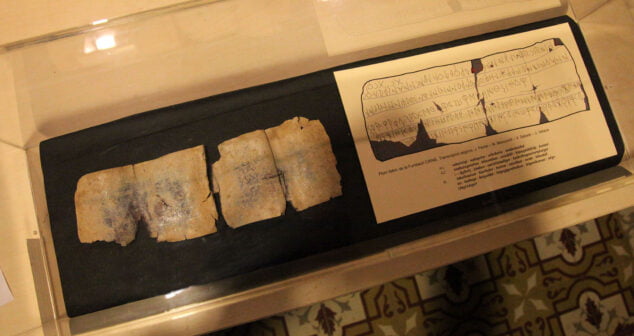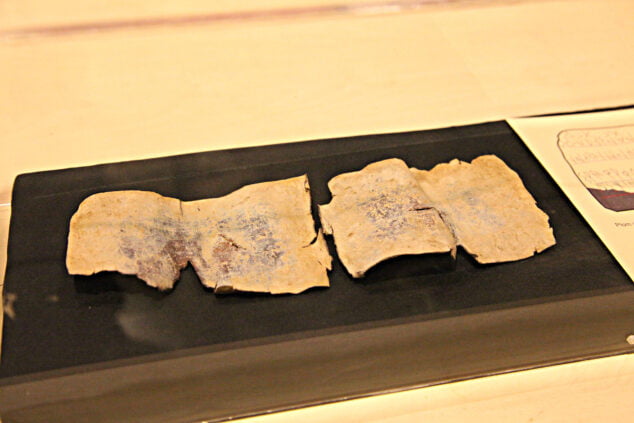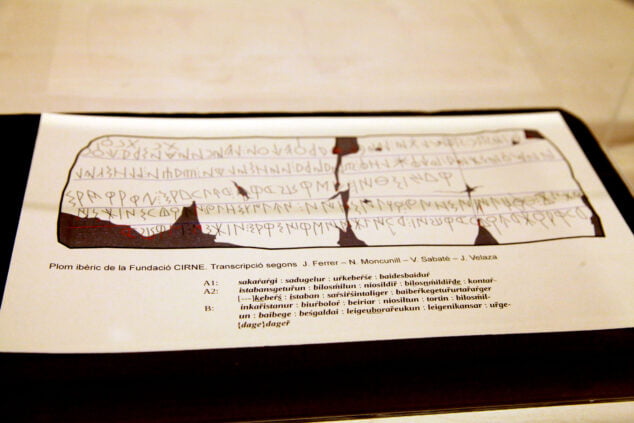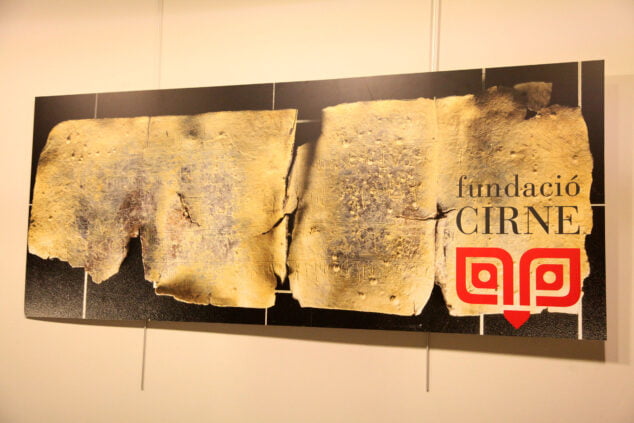A new treasure was hidden in Xàbia. This time it is an exceptional Iberian lead from the XNUMXth century BC. A "magnificent" piece, according to the expert in Paleohispanic Epigraphy, Joan Ferrer i Jané, this past Friday at the presentation of this find.
Iberian lead, dated between the 200th and XNUMXrd centuries BC. C., has a peculiarity that makes it even more special; and it is that it contains an Iberian incised writing of the dual northeastern variant. The lead has XNUMX signs inscribed and is in a good state of preservation.
The piece arrived at the Cirne Foundation through an "anonymous donation three years ago," said the Foundation's president, Enric Martínez. Since then, the investigation work to verify its authenticity and discover the message it hides has been exhaustive. The lead belongs to the geographical area of the Marina Alta, and after being donated to Cirne, it was immediately brought to the attention of the director of the Soler Blasco Museum, Ximo Bolufer.
The Valencian Institute of Conservation, Restoration and Research (IVCR + i) and the Littera group of the University of Barcelona (made up of researchers, professors and professors of classical philology and epigraphy) have been the ones who have accredited that the piece is Iberian.
Iberian lead study
The piece has been cleaned by the IVCR + i and Ferrer i Jané has been the one who has transcribed the signature. Although not all the characters can be understood, the expert has identified Iberian proper names and believes that the text is
related to worship and religion.
On the other hand, the Littera group will publish, next year, an exhaustive study in "Spanish Archeology Archive", the prestigious scientific journal of the CSIC.
Exhibition
The lead of Xàbia, which is how it has been presented at the Cirne Foundation, will be exhibited at the Soler Blasco Museum together with others treasures Xàbia.
In the presentation were the Mayor of Xàbia, José ChulviThe councilman of Culture, Quico Moragues, and the director of the IVCR + i, Gemma Contreras, who explained the techniques that had been used to clean and consolidate this lead, which will help to get to know the mysterious Iberian culture a little better.
[gallery columns = "2" size = "medium" ids = "124587,124597,124598,124599"












And the lead came to revise the llitera group on supplying noms of person. The Iberians undertake noms compostos com avui di tenim: Josep LLuis, Joan Lluc, etc. Hem to separate those noms and veure the corelations in other zones. Sakar Argi, Nios Iltun, Nios Iltir, Bilos Milun and Bilos nMildir ha els vaig comment on the noms acabats in «you» thought they are of focea influence. Ja que tenim noms Masaliotas com: Ximos, Protos, Exenios, amb finalitssació in "os". The one that is curious is that in Bilos Milun s'afegeix a M ja that the name in Iber was ILUN. On this page I also see the trobem in inscriptions of Lugdunum Convenarum in the Roman occupation period for the sake of: ILUNno deo, AstoILUNus deo. Així can see that these people share the same places in the region with the most probable taste of the mateixos migrantis movements d'inicis de l'edat del bronze. The mateix succeeix with the compost name: Bilos NMildir. On the iber name it would normally be ILDIR / Iltir. Here afegeixen n'M devant.
BIUR Bolor also works in the lead of Xàbia and is npc On Biur the tenim documentat abundantly in other Iberian writings. Biur Tanes (ref.hesperia: GI.15.04), Biur Tibas (ref. Hesperia: GI.15.05), Ullastret./ Biur Taker: ref. hesperia: V.17.02, Biur Iltir: V.17.02. On being able to segment Bi + Ur. On bi corresponds to numeral 2 and Ur means water in Indo-European. Could it be a barreja de les dues llengües? doncs no ho know. The fact is that the numerals are present in the personal names like ba / Ban, bi / Bin, Laur, Bors, Sei.Hi has the comparative theory of llatins noms: Primus, Secundus, Quintus, Nono, etc ... Amb el segon nom BOLOR that does not have references so old that the lead has dated from the IV segment, and Tenim the female Bolora in the Bronze of Botorrita III. On veig que masculi = Bolor / Femeni = Bolor. ref hesperia: Z.09.03 To consult these references heu d'entry on the web: hesperia.ucm.es Enter in epigraphic base. Fiqueu the reference and click send. You will sort out the complete fitxa with the explanation of the professionals. Tar Arker could be because both Tar had different names and also Arker. Ista + Ban have no references, I will wait for them to say the group LLitera. Yes, Istar.
Sakar Argi is an Iberian compound name where the name Sakar is repeated in: Sakar isker (Alcoi) and in Sakar Bas (Moixent), Sakar Betan (Benassal) and others for Catalonia and Pech Maho. Argi in turn is documented in the necropolis d'Ensérune in two Greek Attic craters, inscribed in Iberian: Argi Tibas + ar. and in the other crater it says Argi. (Exhibition L'enigma iber MAC Barcelona until mid-January) Argi means light in Basque with which I share Joan Ferrer's theory that Iberian and Old Basque were related languages of the same groups migratory, surely from the Bronze Age, plus those arriving in the Iron Age (fields of urns). With what we are facing a mixture of different human groups. Argi contains the root "arg" which is Indo-European meaning anything shiny. Thus light, and argi + senti = sunrise in current Basque and Argent in French, argentum in Latin Argos in Greek. Thus we see that both Argi Iberian, Argi Basque and Argos Greek have the same root. Sakar I don't know but he seems to be from the Anatolian or Caucasian area. (Personal opinion) Other names that appear in this lead from Xàbia are: Nios Ildir, Nios Iltun. Documented elsewhere we have Nios Isker, Ablonios and Baise Nios. The names ending in "you" I think are of Phoceous Greek origin such as: Bilos Milun, Bilos Nmildir. There is the possibility of an adoption of Greek names or that they were Phoceans directly mixed with Iberians. The fact is that personal names tell us about a great mix of different cultures and ethnic groups coexisting in the same territory. Kon + Tar is np the same as Tor + Tin: Tortin. Iberian names are formed with short segments that come together according to the combinations. URKE Berse is similar to other names that begin with urke such as: Urke Adin (Alto Chacón), Urke Kere (Castellón), Urke Tiker (Moixent), etc… URGE Dager has similarity to Urge from Germanic. So there is quite a mix even in personal names and also others of Canaanite influence due to trade with the Phoenicians and the colonies of Ibiza. In January I will publish a list with the majority of Iberian personal names and I will publish it on my blog, hoping it will be of interest to everyone. Signarioiber.wordpress.com